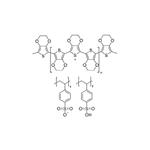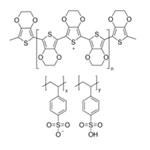Poly(3,4-ethylenedioxythiophene)-poly(styrenesulfonate), also named PEDOT: PSS, belongs to organic/polymer TE materials and has the advantages of water-processable, thermally stable, and can be highly conductive[1]. The charge storage of PEDOT:PSS in supercapacitors is due to redox reactions[2]. It is commonly included as an electroactive conductor in various organic devices(supercapacitors, displays, transistors, and energy‐converters). For example, spin-coating of the PEDOT:PSS water dispersion on n-type silicon wafer[3].
AI 4083, PH 1000, HTL Solar and HTL Solar 3 for thin-film electronic fabrication
PEDOT:PSS is the subject of a considerable amount of research, and is used for a range of applications within thin-film electronic fabrication. This include perovskite photovoltaics, organic photovoltaics, organic light emitting diodes, transparent conductors, organic electrochemical transistors, flexible electronics, thermoelectric generators, supercapitors, and energy storage
Conductive ink based on the high conductivity grade PEDOT:PSS polymer dispersion. Suitable for deposition and patterning of transparent conductive films using slot die coating and spin coating in OPV application.
Screen Printing results on Autotype Autosta CT7 P77/55 screen with 300 mm/s
Curing temp. 130°C during 3 min
PEDOT:PSS can be used as an electrode material that forms a layered structure with a high mobility for charge carriers. It can be used for a wide range of energy based applications, such as organic photovoltaics (OPVs), dye sensitized solar cells (DSSCs), organic light emitting diodes (OLEDs) and supercapacitors.
A conducting polymer such as poly(3,4-ethylenedioxythiophene) doped with poly(styrene sulfonate) anions (PEDOT/PSS) is widely used in various organic optoelectronic devices. PEDOT: PSS is a blend of cationic polythiopene derivative, doped with a polyanion. High electrical conductivity and good oxidation resistance of such polymers make it suitable for electromagnetic shielding and noise suppression. Thus, the polymer film was found to possess high transparency throughout the visible light spectrum and even into near IR and near UV regions, virtually 100% absorption from 900-2,000 nm. No absorption maximum from 400-800 nm. Impact of small electric and magnetic fields on the polymer was studied.
[1] Kurushima Y, et al. Effect of PEDOT:PSS composition on photovoltaic performance of PEDOT:PSS/n-Si hybrid solar cells. Japanese Journal of Applied Physics, 2021; 60: 091001.
[2] Fan Z, et al. Thermoelectric Properties of PEDOT:PSS. Advanced Electronic Materials, 2019; 5: 1800769.
[3] Volkov A, et al. Understanding the Capacitance of PEDOT:PSS. Advanced Functional Materials, 2017; 27: 1700329.



